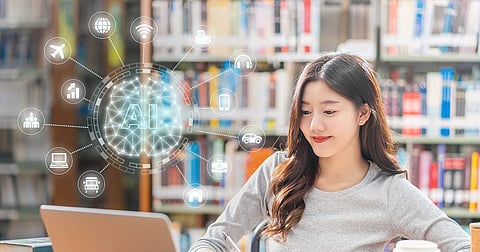
- NEWS
- the EDIT
- COMMENTARY
- BUSINESS
- LIFE
- SHOW
- ACTION
- GLOBAL GOALS
- SNAPS
- DYARYO TIRADA
- MORE

With the growing importance of digital tools in the evolving education landscape, educational institutions recognize the need to adapt to innovative technologies such as artificial intelligence in the academic setting.
To fully utilize its benefits without compromising academic standards, the Far Eastern University for instance updated its Academic Integrity policies with a set of guidelines on the responsible and ethical use of AI for its faculty and students. The guidelines aim to implement policies regarding transparency and limitations of use and place utmost importance on maintaining FEU’s principle of student-centered pedagogy and learning.
“AI has been here for a long time, and FEU welcomes its use as an educational tool. However, it should not serve as a replacement for actual students’ performance. That’s why we needed to come up with a policy highlighting academic integrity, and we also conduct workshops to guide students on the proper use of AI tools,” Maria Teresa Trinidad Tinio, FEU senior vice president for Academic Affairs, said.
Educational tool
According to the 2024 Work Trend Index conducted by Microsoft Philippines and LinkedIn, 86 percent of knowledge workers in the Philippines use AI tools. This signals a growing industry demand for graduates who are equipped with necessary AI skills and therefore calls on its integration in the higher education learning process.
Under FEU’s new directives, the use of AI as an educational tool is encouraged in so far as it promotes “persuasive communication, intellectual curiosity, critical thinking, creative problem solving, professionalism and responsible digital citizenship” among students.
Faculty members receive training and workshops that increase their familiarity and competence with AI technologies. This will equip them to incorporate AI capabilities in designing pedagogical activities and materials and empowers them to effectively guide students in using the tools as well.
Transparency, limitations
While fully acknowledging the opportunities that AI presents to advance quality education, FEU warns against the indiscriminate use of the technology and raises awareness of its limitations.
Among its limitations is its tendency for “hallucination,” which involves creating false citations, making incorrect calculations and providing incorrect data — all of which are potentially harmful to students who become overly reliant on the technology.
“The teachers also have to be wise, and they need to know their students’ capabilities, including their writing styles, among others. When they assess their students, they have to ensure that the use of AI is still aligned with the students’ learning outcomes,” Tinio explained.
FEU’s guidelines require students to be transparent of the AI tools used in their outputs and assessments.
Continued non-compliance may potentially lead to being flagged for academic dishonesty.
